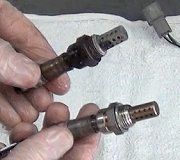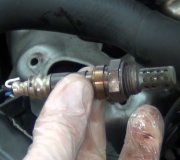The valve is controlled by voltage in this case but I never experimented with one to see how they vary that voltage.
The Chrysler / GM system uses a stepper motor which is not a motor with brushes like we normally think of one that spins. The coils of wire are pulsed with varying voltages and polarities to bump the armature to various positions. There are no voltage pulses when the computer wants the motor to stay right where it is. That's why it will stay where it is when you unplug it.
On the Ford system it is a solenoid that has a spring-loaded plunger. Higher voltage makes a stronger magnetic field that pulls the plunger more to expose more of the air passage around the throttle blade. There's two ways to vary that voltage, and that's what I never looked at. The easiest way to understand is simply applying more and more voltage to open the valve more and more. That will work fine but if you understand electrical theory, that means that at any point other than fully-open and fully-closed, there is going to be some voltage across and some current flow through the controlling transistor. Voltage times current equals power, (watts), and power results in heat. (We have to do it that way in home audio amplifiers to prevent distortion, and that's why they have the huge finned aluminum heat sinks on the back). Heat is the deadly enemy of transistors. If we switched everything on cars that way, every computer would have piles and piles of heat sinks on them and each one would be many times larger than they are now.
Instead, most switching circuits on cars use "pulse-width modulation". An injector and an ignition coil are perfect examples of "PWM". The circuit is switch full-on for a period of time and full-off the rest of the time. When the circuit is switched full-on, all the system voltage is placed across the device leaving 0 volts across the switching transistor. 0 volts times any current equals 0 watts and no heat buildup. When the device is switched off there's 0 current flow. 0 amps times any voltage equals 0 watts, so again, no power.
I suspect your idle air valve uses PWM to control its position. The ratio of on-time to off-time is varied to adjust the average amount of voltage thereby adjusting its position. Either way, you need that varying voltage to hold the valve in a specific position. When you unplug it, the return spring is going to retract it to a setting much lower than idle speed. At that point you would need to prop the throttle blade open a little if you want to do the injector test.
As an example, prop the throttle open and lets say you find the engine running at 1200 rpm. Unplug one injector and the engine speeds drops to 1000 rpm. Same with the next three injectors when they're unplugged one at a time, but it doesn't drop at all when you unplug the fifth one. That's the one that isn't contributing any power. At that point you still don't know if you have an injector problem or a spark problem. All you know is that cylinder isn't producing any power. The easiest thing to do is switch the spark plug, and the coil when there's individual coils, with those from a different cylinder, then do the power test again. If you switch the coils and spark plugs from cylinder two, lets say, with cylinder four, and now cylinder four is dead when it was cylinder two before, you know it's the spark plug or coil. If cylinder two is still dead, suspect the injector. You can swap two injectors the same way but that takes a little longer to do.
There is no practical way for you to test an injector. You have no way of learning any more about it than it dribbles a little fluid. You also need to be concerned with volume at a given pressure, and spray pattern. Volume is critical for equal fuel to every cylinder to prevent one from running too rich or too lean, (a huge problem that GM hasn't learned yet). Spray pattern is critical for proper atomization of the fuel. Liquid fuel doesn't burn or contribute to power generation. It causes higher emissions and lower fuel mileage. We used to have intake manifold runners over a foot long that gave the fuel more time to vaporize. Now they get an inch or two from the injector tip to the intake valve to do that. The higher pressures help but if the spray pattern causes the fuel to hit the intake valve, when it is cold yet it can cause "puddling" where the fuel condenses again back to a liquid. That results in cold stumbling and hesitation problems. If you want to learn more about injector testing and the common problems with them, do a Google search for Jim Linder. He has a shop in Indianapolis that specializes in rebuilding injectors, and flow-matching them to solve a lot of GM's problems.
Friday, August 30th, 2013 AT 4:24 PM



